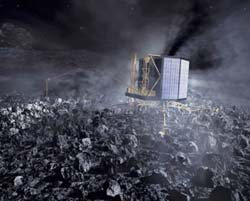Unlocking the secrets of the universe: Rosetta lander named Philae

Rosetta will drop a lander onto a comet for the first time
ESA PR 08-2004. With just 21 days to the launch of the European Space Agency’s Rosetta comet mission, the spacecraft’s lander has been named “Philae”. Rosetta embarks on a 10-year journey to Comet 67P/Churyumov-Gerasimenko from Kourou, French Guiana, on 26 February.
Philae is the island in the river Nile on which an obelisk was found that had a bilingual inscription including the names of Cleopatra and Ptolemy in Egyptian hieroglyphs. This provided the French historian Jean-François Champollion with the final clues that enabled him to decipher the hieroglyphs of the Rosetta Stone and unlock the secrets of the civilisation of ancient Egypt.
Just as the Philae Obelisk and the Rosetta Stone provided the keys to an ancient civilisation, the Philae lander and the Rosetta orbiter aim to unlock the mysteries of the oldest building blocks of our Solar System – comets.
Germany, France, Italy and Hungary are the main contributors to the lander, working together with Austria, Finland, Ireland and the UK. The main contributors held national competitions to select the most appropriate name. Philae was proposed by 15-year-old Serena Olga Vismara from Arluno near Milan, Italy. Her hobbies are reading and surfing the internet, where she got the idea of naming the lander Philae. Her prize will be a visit to Kourou to attend the Rosetta launch.
Study of Comet Churyumov-Gerasimenko will allow scientists to look back 4600 million years to an epoch when no planets existed and only a vast swarm of asteroids and comets surrounded the Sun. On arrival at the comet in 2014, Philae will be commanded to self-eject from the orbiter and unfold its three legs, ready for a gentle touchdown. Immediately after touchdown, a harpoon will be fired to anchor Philae to the ground and prevent it escaping from the comet’s extremely weak gravity. The legs can rotate, lift or tilt to return Philae to an upright position.
Philae will determine the physical properties of the comet’s surface and subsurface and their chemical, mineralogical and isotopic composition. This will complement the orbiter’s studies of the overall characterisation of the comet’s dynamic properties and surface morphology. Philae may provide the final clues enabling the Rosetta mission to unlock the secrets of how life began on Earth.
“Whilst Rosetta’s lander now has a name of its own, it is still only a part of the overall Rosetta mission. Let us look forward to seeing the Philae lander, Osiris, Midas and all the other instruments on board Rosetta start off on their great journey this month,” said Professor David Southwood, ESA Director of Science.
For further information, please contact:
ESA Media Relations Service
Tel: +33(0)1.53.69.7155
Fax: +33(0)1.53.69.7690
Media Contact
More Information:
http://www.esa.int/export/SPECIALS/Rosetta/SEMYMPWA6QD_0.htmlAll latest news from the category: Physics and Astronomy
This area deals with the fundamental laws and building blocks of nature and how they interact, the properties and the behavior of matter, and research into space and time and their structures.
innovations-report provides in-depth reports and articles on subjects such as astrophysics, laser technologies, nuclear, quantum, particle and solid-state physics, nanotechnologies, planetary research and findings (Mars, Venus) and developments related to the Hubble Telescope.
Newest articles

First-of-its-kind study uses remote sensing to monitor plastic debris in rivers and lakes
Remote sensing creates a cost-effective solution to monitoring plastic pollution. A first-of-its-kind study from researchers at the University of Minnesota Twin Cities shows how remote sensing can help monitor and…

Laser-based artificial neuron mimics nerve cell functions at lightning speed
With a processing speed a billion times faster than nature, chip-based laser neuron could help advance AI tasks such as pattern recognition and sequence prediction. Researchers have developed a laser-based…

Optimising the processing of plastic waste
Just one look in the yellow bin reveals a colourful jumble of different types of plastic. However, the purer and more uniform plastic waste is, the easier it is to…


